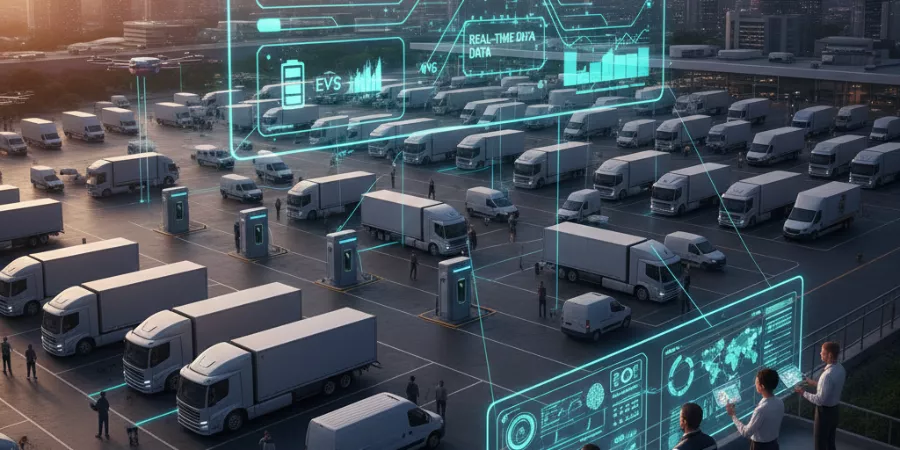Fleet management is about to undergo a significant change. The worldwide market for fleet management systems is valued at approximately USD 27.5 billion in 2025. It might increase to more than USD 72 billion by 2035. Such a magnitude indicates not only the expansion of the business but also a major change. Fleets are not only a set of vehicles which are used and maintained.
They are, in fact, data-rich platforms, the main source of sustainability, and most important, the means that can be used to achieve efficiency. In essence, the companies which will take the challenge to radically change their way of future of fleet management will be able to obtain a strong competitive advantage.
What is Fleet Management?
Fleet management is essentially the handling of the processes, systems, and individuals that ensure the effectiveness of a company’s vehicles or transport assets from purchase to disposal.
It involves a wide range of activities such as the purchasing of vehicles, maintenance scheduling, real-time fleet tracking of vehicles, fuel consumption management, and compliance with regulations.
Fundamentally, fleet management revolves around overseeing three major aspects: cost control, safety, and efficiency. Through the use of telematics systems (real-time GPS plus diagnostic systems), organizations can monitor vehicle utilization, predictive maintenance, and driving behavior.
Most of the current fleet management systems have widely adopted digital technologies, cloud applications, IoT fleet solutions, and data analysis for transforming raw data into actionable insights. Fleet management basically means the careful monitoring and controlling of a company’s transport assets aiming to create more value, reduce risk and cost, and improve safety and uptime.
The Rising Market: Growth and Opportunity
The expansion here is very much real and non-theoretical. Several reports predict that the fleet management market will grow at double-digit growth rates over the next ten years. Another forecast, by the same token, expects the market to reach 70 billion USD by 2034, growing at a compound annual growth rate of around 10%.
Such a demand underpins these numbers: companies in freight, public transport, building, and last-mile delivery sectors are embracing smart fleet management solutions to cut costs, increase safety, comply with regulations, and, in some cases, even to achieve environmental goals through eco-friendly fleet management.
Key Trends & Future of Fleet Management
- Rapid Market Growth: The future of fleet management industry is going to grow hugely over the next few years. It is predicted that the market will increase from approximately USD 32 billion in 2025 to USD 153 billion by 2035. Such a projection reflects strong demand: companies are eager to make their vehicle operations more efficient, safer, and eco-friendly.
- Artificial Intelligence and Predictive Analytics: AI in fleet management is the single biggest factor that will shape the future. Transformational is how fleet managers most frequently describe it. According to a global survey, 58% of fleet managers state that within five years they will be implementing AI in fleet management, mostly for predictive maintenance and route planning. By analyzing data from on‑board sensors, AI in fleet management can identify a failure even if it is going to happen in the future. This makes the prevention of breakdowns possible and the reduction of downtime. Besides that, how AI is transforming future of fleet management also includes fleet optimization through AI-powered route planning, which can use the current traffic, previous traffic, and vehicle conditions to conserve the fuel and time needed by the trips.
- Electrification and EV Fleet Management: Electric vehicles in fleet are not only fashionable but are also the main point of the future of electric vehicle fleets according to fleet managers. The adoption of EV and hybrid is forecasted to rise rapidly. However, a fleet consisting of only EVs comes with a few complications. The managers are required to prepare for installing charging stations, keep an eye on the battery status, and facilitate the scheduling of charging so that their cars are always in a ready state. The AI will assure the timely and complete charging of the fleet by calculating and corresponding the required charging with free slots.
- Connectivity: Telematics, IoT, and 5G: Real-time transparency is still the base of fleet upgrading. Along with the IoT-enabled sensors, the telematics system is used for gathering information of the vehicle and driver. Moving forward, 5G will be the major player that will extend this potential. The connection that is quicker and more reliable than ever will enable the free flow of data between the vehicles and the central control units. The progressive software will engage this communication to real-time data in fleet management, delivering notifications, services of diagnostics, and ongoing observation.
- Autonomous Driving and Safety Systems: Most fleets are starting to integrate driver-assistance features and autonomous technologies, though gradually. Features such as adaptive cruise control, lane keeping, and even some self-driving abilities will slowly infiltrate commercial fleet operations. Simultaneously, the use of cameras and video telematics in fleet safety monitoring will increase, as these tools can monitor driver behavior, identify dangerous activities, and aid the training process.
- Sustainability and Carbon Tracking: Sustainability is no longer a side issue and has become a major part of the conscious management of a fleet. In order to achieve green goals, fleets will gradually adopt the use of such means as eco-driving instruments, emissions-monitoring devices, and electric vehicles in the fleet. Measuring carbon footprints in fleets will give the fleet managers an understanding of their impact on the environment and, therefore, they will be able to make data-driven fleet decisions that contribute to the achievement of sustainability goals.
- Fleet Renewal, Optimization, and Lifecycle Decisions: By way of advanced fleet optimization methods, vehicle fleets will be in a stronger position to figure out when the time comes for them to either refresh or renew their motorcars. Research is gradually emerging indicating that machine learning can be the main decision maker in which vehicles are to be left, the best time for retrofitting, and how a balance between cost and utility can be achieved. In particular for electric vehicles in fleet, data-driven fleet decisions will be instrumental in providing the best solutions for EV fleet charging infrastructure, scheduling, as well as resource allocation. Fleet lifecycle management is becoming a key priority for efficient operations.
- Cybersecurity and Data Privacy: The internet connection comes with more risks. The amount of data collected by the fleets like location, health diagnostics, and driver behavior is directly proportional to the necessity of ensuring this data’s safety. In case an organization’s security gets compromised, it not only would cause a disruption in the organization’s operations but also would result in a financial loss and a tarnished reputation. Thus, the era of cybersecurity in fleet management will be accompanied with the installation of stringent security measures and the provision of privacy protections at the same time.
- Business Models: Fleet-as-a-Service and Subscription Models: The biggest change will be the extensive use of Fleet-as-a-Service (FaaS) models that we are going to witness. Companies instead of vehicle purchasing may lease electric vehicles in fleet through a subscription-type arrangement. The move cuts the initial cost, shifts the risk, and makes the price correspond to the level of use. By the use of telematics systems and data analytics, the smart platforms that facilitate the implementation of these models will become more productive by thus reducing the time that the vehicle cannot be used, foreseeing the predictive maintenance, and managing the fleet lifecycle management of vehicles.
Challenges That Will Shape the Future
- High Upfront Costs and Infrastructure Expense: Modernization of future of fleet management systems, especially electric vehicles in fleet, requires huge capital outlay. Fleet management managers find themselves with high costs associated with electric vehicles in fleet purchases, EV fleet charging installation, and mainframes and software upgrading. One of the most expensive undertakings is the charging infrastructure deployment. Many operators often use TCO modeling as the only method to elaborate and justify costs, but still, many companies lack accurate and timely TCO tracking tools.
- Limited Charging Infrastructure and Range Constraints: Sure enough, the aggressive electrification strategies have been set in place, but still, the charging infrastructure shortage problem is faced by many fleet management The presence of such infrastructure gaps not only creates the issue of range anxiety but also limits the choice of routes. In addition to that, charging coordination for a large-scale electric vehicles in fleet is a pretty hard task: balancing loads, demand during peak times, and charging duration are still the main operation hurdles.
- Integration with Legacy Systems: There are still many organizations that prefer to use the outdated fleet management systems or old IT infrastructure in their operations. The integration of new telematics systems, EV-management software, or IoT fleet solutions is often complex, resulting in escalation of costs, project timelines, and risks.
- Data Overload, Governance, and Interoperability: Massive amounts of data are produced by contemporary fleet systems including GPS, sensor diagnostics, battery telemetry, driver behavior, and several other systems. It is extremely difficult to handle, analyze and derive valuable insights from that data. In addition, the lack of uniformity between different devices and platforms complicates the process of integrating data.
- Cybersecurity and Privacy Risks: With a very connected world, the risk of attacks will also increase proportionately. Fleet management systems, especially the ones that deal with electric vehicles in fleet, are the most likely to experience cyberattacks. A hacker might stop the process, change the data, or get the power to issue negative commands to the vehicles. What is needed is very strong security measures, constant vigilance, and encryption that is hard to crack as the only way to secure both personal and business information. Compliance with local data privacy laws poses even greater challenges.
- Regulatory Uncertainty and Residual Value Risk: Fleet management managers have to deal all the time with the undecided emission, tax, and data matters that the authorities are granting different rights on. In case of certain areas, the question of government policies regarding the incentives for EVs and the residual values of cars is still open. Oscillation of residual values for electric vehicles in fleet could, for instance, make leasing or financing more risky. Besides, the arrival of new regulations may necessitate the sudden change of future of fleet management strategies, thereby putting long-term planning under pressure.
- Payment and Charging Network Fragmentation: Charging of electric vehicles in fleet has not been standardized yet. Differences in payment systems, authentication protocols, and charging network interoperability exist. This adds to the complexity of fleet management for smooth billing, driver reimbursement, or charging data getting integrated into their overall operations.
- Operational Challenges and Change Management: The future of fleet management switch to new systems is a file of training along with the change management. The staff will be trained on new tools, and drivers, managers, and technicians will work their completely different processes. Resistance to change, lack of technical skills, or slow adoption may be some of the possible causes of the situation.
- Scalability and Growth Constraints: The growth of the electric vehicles in fleet requires systems to evolve in a way that they would easily be able to accommodate more vehicles, greater volumes of data, and more complex operations. Maybe some platforms will not be able to comfortably stretch, thus the fleets will need to go through a process of rebuilding or reconfiguration when they grow.
- Reliability and Network Connectivity: Most of the predictive maintenance and telematics systems are cloud-based and need the internet for their operation. But in less accessible areas or network zones that are not stable, these systems might experience delay or loss of connection. In the case of an electric vehicles in fleet where real-time data in fleet management is very important, this situation can lead to a lack of visibility and sub‑optimization of operations.
- Battery and Grid Risks: The extended electric vehicles in fleet operation has introduced new demands to the power distribution network. Among these are the risks of dynamic electricity pricing, peak demand, and load management. At the same time, battery depletion or irregularities must be monitored very closely because if such monitoring is not carried out it may result in increased maintenance costs and decreased vehicle availability.
Real‑World Examples: How Fleets Are Evolving
- Penske Truck Leasing is an excellent example of future of fleet management that utilizes data effectively. With the help of telematics systems installed in trucks and an AI platform called Catalyst AI, Penske gathers a vast amount of data related to engine performance, temperature, braking, and fuel efficiency and then it is able to predict when the predictive maintenance will be required. So instead of break-downs, Penske’s network warns about the potential mechanical issues at the early stage, thus a costly idle time can be avoided. What’s more, Penske’s customers are taking advantage of this as well: for instance, a local dairy cooperative that leases trucks from Penske can utilize these AI in fleet management insights to manage hoses, tires, fuel, and other maintenance items in a proactive manner.
- Samsara is a leading IoT fleet solutions– and telematics systems‑based fleet management Its solution provides real-time fleet tracking into vehicles, monitors driver behavior via video telematics, and supports predictive maintenance. Fleet managers have an opportunity to identify risky driving (e.g., sudden braking) through its dashboards, give the appropriate instructions to their drivers, and be aware of the upcoming service before the breakdown occurs. Such kind of data-driven fleet decisions is instrumental in the reduction of fleet accident risks and increase of uptime.
- Amazon has tested the viability of AI in future of fleet management powered automated vehicle inspections in their delivery vans. Using high-resolution cameras and machine-learning software developed by a third party, Amazon scans undercarriages, tires, and exteriors to detect situations that require repair or maintenance. Thus, the manual inspection is minimized, and the whole process is expedited, while at the same time, safety-critical issues are identified earlier.
- Volvo Trucksis using AI in future of fleet management to foresee the maintenance needs of its fleet management of commercial vehicles. The company equips sensors to the engines, transmissions, and other parts of the vehicle to collect data. Then, the AI comes in and it recognizes the patterns to predict the wear and failure thus giving enough time to Volvo or its customers to schedule the predictive maintenance beforehand instead of waiting for the dreaded breakdown. The implication of this is a lot less money wasted and a lot more smooth running of operations.
- Trio Mobil combines the power of the Internet of Things and AI in fleet management to bring about operational safety in the industrial fleets. Using the help of a video analytics system (True‑AI), it keeps a constant vigil on the vehicle surroundings, identifies the potential safety risks, and notifies the fleet managers immediately. Their platform also collects location data that facilitates better decision making, lowers the risk and makes the utilization of the vehicles more efficient.
Conclusion
It is pretty evident from today how future of fleet management will be in the coming days, smart, interconnected, eco-friendly, and empathetic to the human nature. These fleets that will utilize telematics systems, AI in future of fleet management, cloud, and electric vehicles in fleet will not only save money but also will change the whole concept of what it means to operate efficiently and responsibly.
The benefits of this move are tangible: lower fuel costs, fewer accidents, a driver’s pool more satisfied, and less impact on the environment. On the contrary, the danger of not moving at all is becoming obsolete. A carefully planned, data-driven fleet decisions strategy is the key to opening up the potential and composing a fleet management that is not only efficient but also environmentally friendly over the next years.







